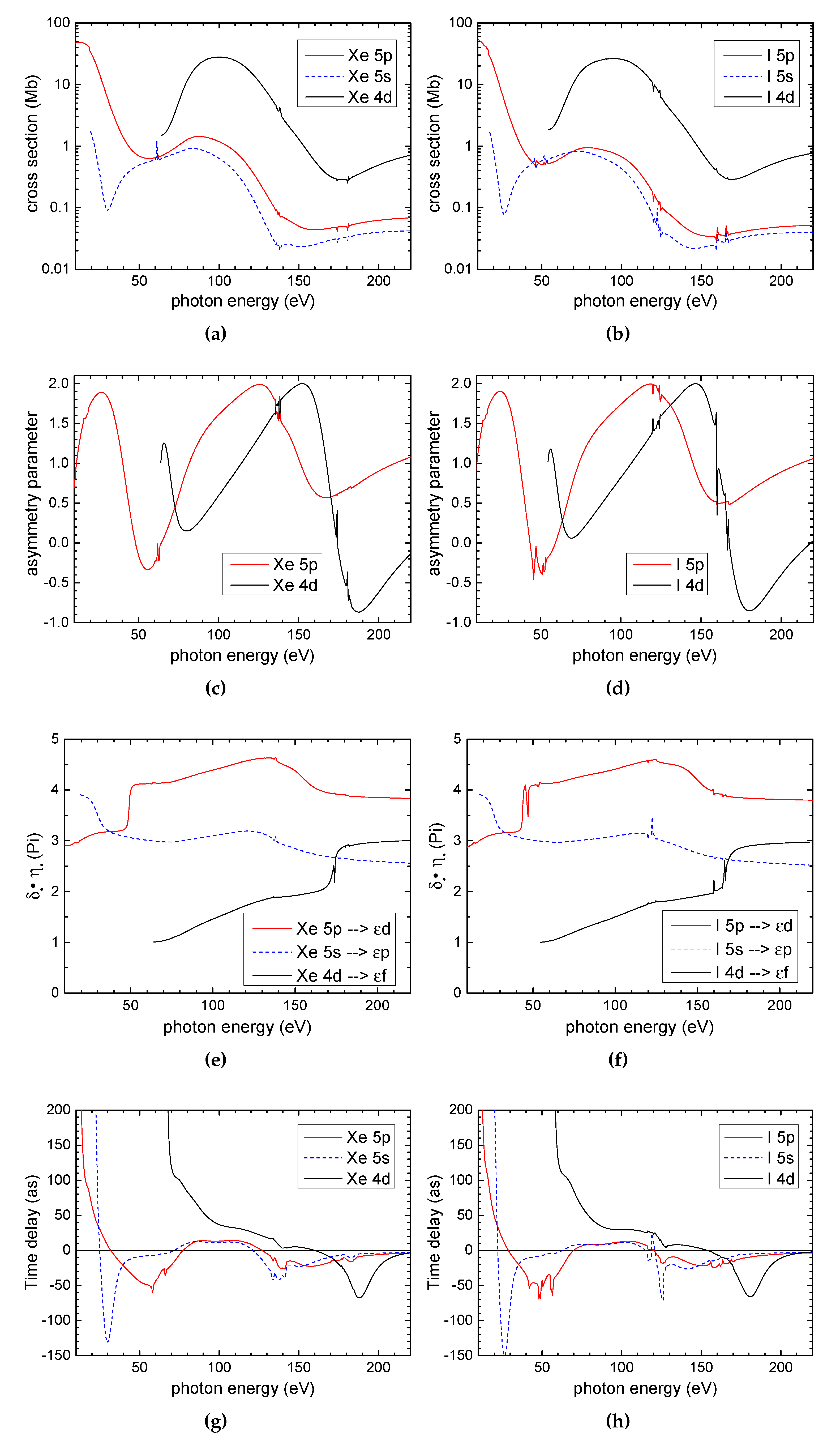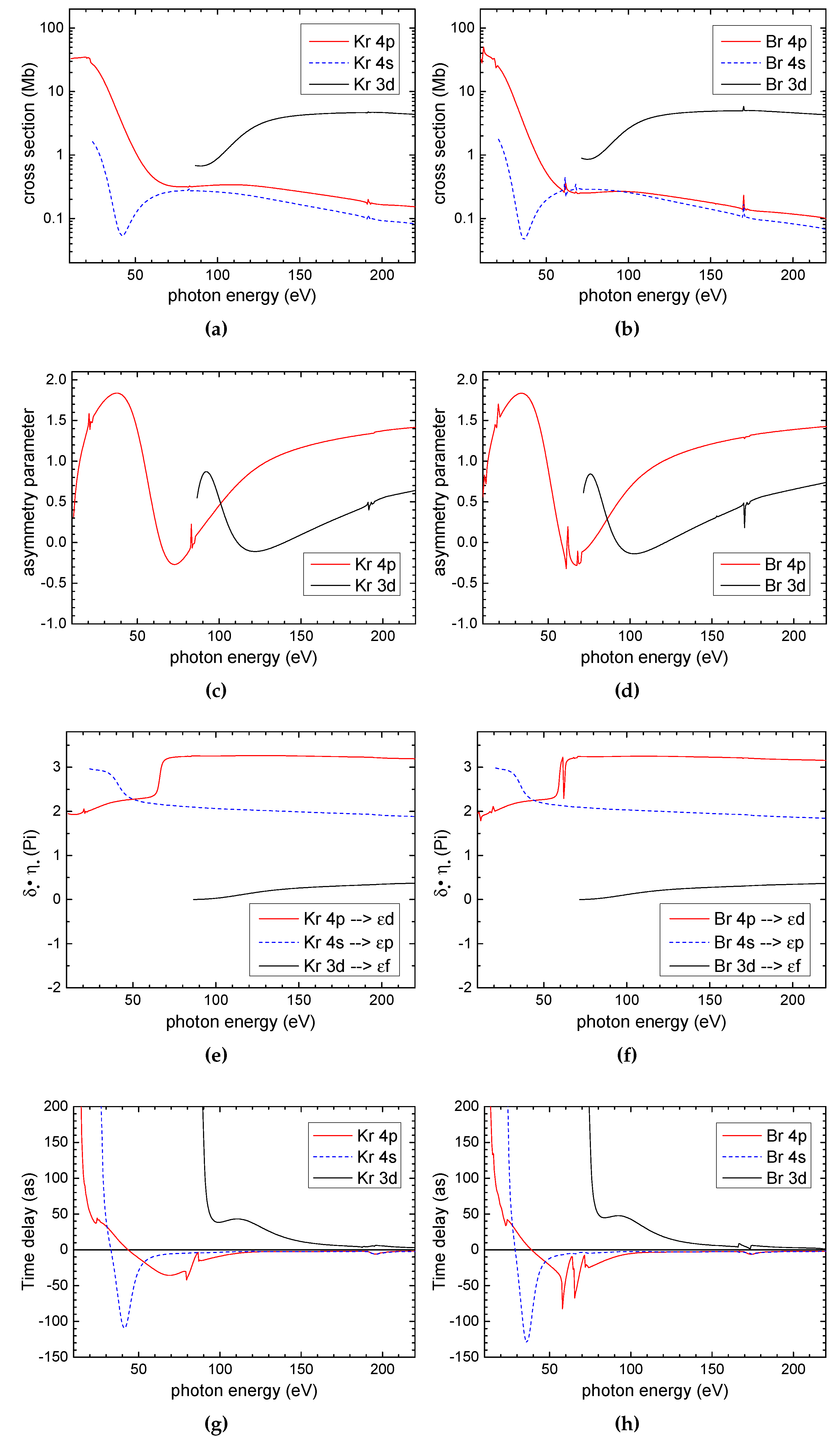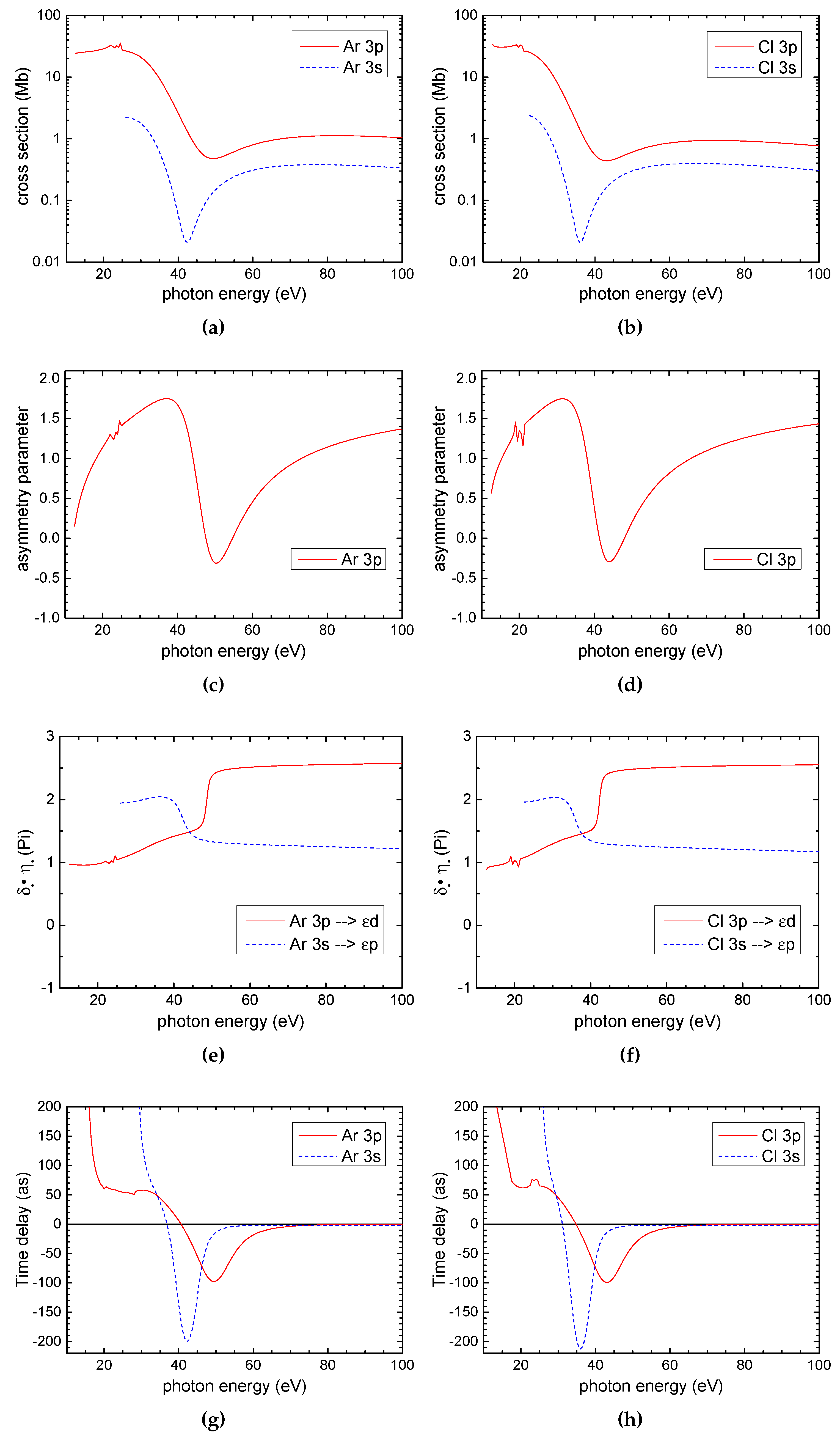Attosecond Time Delay in Photoionization of Noble-Gas and Halogen Atoms
Abstract
:1. Introduction
2. Overview of Theoretical Methods
2.1. Independent-Electron Approach
2.2. Inclusion of Collective Effects by Time-Dependent Local-Density Approximation
3. Results and Discussion
3.1. General Features
3.2. Phase Shift and Time Delay in the Vicinity of Giant Resonance and Cooper Minimum
4. Conclusions
Acknowledgments
Author Contributions
Conflicts of Interest
Abbreviations
| attosecond ( s) | |
| atomic units | |
| CLC | Coulomb-laser coupling |
| IR | Infrared |
| RABBIT | Reconstruction of attosecond harmonic beating by interference of two-photon transitions |
| (TD)LDA | (Time-dependent) local-density approximation |
| XUV | extreme ultraviolet |
References
- Schmidt, V. Photoionization of atoms using synchrotron radiation. Rep. Prog. Phys. 1992, 55, 1483. [Google Scholar] [CrossRef]
- Becker, U.; Shirley, D.A. (Eds.) VUV and Soft X-ray Photoionization; Springer: Boston, MA, USA, 1996. [Google Scholar]
- Drescher, M.; Hentschel, M.; Kienberger, R.; Tempea, G.; Spielmann, C.; Reider, G.A.; Corkum, P.B.; Krausz, F. X-ray Pulses Approaching the Attosecond Frontier. Science 2001, 291, 1923–1927. [Google Scholar] [CrossRef] [PubMed]
- Hentschel, M.; Kienberger, R.; Spielmann, C.; Reider, G.A.; Milosevic, N.; Brabec, T.; Corkum, P.; Heinzmann, U.; Drescher, M.; Krausz, F. Attosecond metrology. Nature 2001, 414, 509–513. [Google Scholar] [CrossRef] [PubMed]
- Paul, P.M.; Toma, E.S.; Breger, P.; Mullot, G.; Augé, F.; Balcou, P.; Muller, H.G.; Agostini, P. Observation of a Train of Attosecond Pulses from High Harmonic Generation. Science 2001, 292, 1689–1692. [Google Scholar] [CrossRef] [PubMed]
- Ossiander, M.; Siegrist, F.; Shirvanyan, V.; Pazourek, R.; Sommer, A.; Latka, T.; Guggenmos, A.; Nagele, S.; Feist, J.; Burgdörfer, J.; et al. Attosecond correlation dynamics. Nat. Phys. 2017, 13, 280–285. [Google Scholar] [CrossRef]
- Schultze, M.; Fiess, M.; Karpowicz, N.; Gagnon, J.; Korbman, M.; Hofstetter, M.; Neppl, S.; Cavalieri, A.L.; Komninos, Y.; Mercouris, T.; et al. Delay in photoemission. Science 2010, 328, 1658–1662. [Google Scholar] [CrossRef] [PubMed]
- Klünder, K.; Dahlström, J.M.; Gisselbrecht, M.; Fordell, T.; Swoboda, M.; Guénot, D.; Johnsson, P.; Caillat, J.; Mauritsson, J.; Maquet, A.; et al. Probing Single-Photon Ionization on the Attosecond Time Scale. Phys. Rev. Lett. 2011, 106, 143002. [Google Scholar] [CrossRef] [PubMed]
- Guénot, D.; Klünder, K.; Arnold, C.L.; Kroon, D.; Dahlström, J.M.; Miranda, M.; Fordell, T.; Gisselbrecht, M.; Johnsson, P.; Mauritsson, J.; et al. Photoemission-time-delay measurements and calculations close to the 3s-ionization-cross-section minimum in Ar. Phys. Rev. A 2012, 85, 053424. [Google Scholar] [CrossRef]
- Palatchi, C.; Dahlström, J.M.; Kheifets, A.S.; Ivanov, I.A.; Canaday, D.M.; Agostini, P.; DiMauro, L.F. Atomic delay in helium, neon, argon and krypton. J. Phys. B At. Mol. Opt. Phys. 2014, 47, 245003. [Google Scholar] [CrossRef]
- Sabbar, M.; Heuser, S.; Boge, R.; Lucchini, M.; Carette, T.; Lindroth, E.; Gallmann, L.; Cirelli, C.; Keller, U. Resonance Effects in Photoemission Time Delays. Phys. Rev. Lett. 2015, 115, 133001. [Google Scholar] [CrossRef] [PubMed]
- Lindroth, E.; Dahlström, J.M. Attosecond delays in laser-assisted photodetachment from closed-shell negative ions. Phys. Rev. A 2017, 96, 013420. [Google Scholar] [CrossRef]
- Haessler, S.; Fabre, B.; Higuet, J.; Caillat, J.; Ruchon, T.; Breger, P.; Carré, B.; Constant, E.; Maquet, A.; Mével, E.; et al. Phase-resolved attosecond near-threshold photoionization of molecular nitrogen. Phys. Rev. A 2009, 80, 011404. [Google Scholar] [CrossRef]
- Huppert, M.; Jordan, I.; Baykusheva, D.; von Conta, A.; Wörner, H.J. Attosecond Delays in Molecular Photoionization. Phys. Rev. Lett. 2016, 117, 093001. [Google Scholar] [CrossRef] [PubMed]
- Locher, R.; Castiglioni, L.; Lucchini, M.; Greif, M.; Gallmann, L.; Osterwalder, J.; Hengsberger, M.; Keller, U. Energy-dependent photoemission delays from noble metal surfaces by attosecond interferometry. Optica 2015, 2, 405–410. [Google Scholar] [CrossRef]
- Tao, Z.; Chen, C.; Szilvasi, T.; Keller, M.; Mavrikakis, M.; Kapteyn, H.; Murnane, M. Direct time-domain observation of attosecond final-state lifetimes in photoemission from solids. Science 2016, 353, 62–67. [Google Scholar] [CrossRef] [PubMed]
- Moore, L.R.; Lysaght, M.A.; Parker, J.S.; van der Hart, H.W.; Taylor, K.T. Time delay between photoemission from the 2p and 2s subshells of neon. Phys. Rev. A 2011, 84, 061404. [Google Scholar] [CrossRef]
- Zhang, C.H.; Thumm, U. Streaking and Wigner time delays in photoemission from atoms and surfaces. Phys. Rev. A 2011, 84, 033401. [Google Scholar] [CrossRef]
- Caillat, J.; Maquet, A.; Haessler, S.; Fabre, B.; Ruchon, T.; Salières, P.; Mairesse, Y.; Taïeb, R. Attosecond Resolved Electron Release in Two-Color Near-Threshold Photoionization of N2. Phys. Rev. Lett. 2011, 106, 093002. [Google Scholar]
- Sukiasyan, S.; Ishikawa, K.L.; Ivanov, M. Attosecond cascades and time delays in one-electron photoionization. Phys. Rev. A 2012, 86, 033423. [Google Scholar] [CrossRef]
- Nagele, S.; Pazourek, R.; Feist, J.; Burgdörfer, J. Time shifts in photoemission from a fully correlated two-electron model system. Phys. Rev. A 2012, 85, 033401. [Google Scholar] [CrossRef]
- Dahlström, J.M.; L’Huillier, A.; Maquet, A. Introduction to attosecond delays in photoionization. J. Phys. B At. Mol. Opt. Phys. 2012, 45, 183001. [Google Scholar] [CrossRef]
- Dahlström, J.M.; Carette, T.; Lindroth, E. Diagrammatic approach to attosecond delays in photoionization. Phys. Rev. A 2012, 86, 061402. [Google Scholar] [CrossRef]
- Pazourek, R.; Feist, J.; Nagele, S.; Burgdörfer, J. Attosecond Streaking of Correlated Two-Electron Transitions in Helium. Phys. Rev. Lett. 2012, 108, 163001. [Google Scholar] [CrossRef] [PubMed]
- Dahlström, J.; Guénot, D.; Klünder, K.; Gisselbrecht, M.; Mauritsson, J.; L’Huillier, A.; Maquet, A.; Taïeb, R. Theory of attosecond delays in laser-assisted photoionization. Chem. Phys. 2013, 414, 53–64. [Google Scholar] [CrossRef]
- Kheifets, A.S. Time delay in valence-shell photoionization of noble-gas atoms. Phys. Rev. A 2013, 87, 063404. [Google Scholar] [CrossRef]
- Feist, J.; Zatsarinny, O.; Nagele, S.; Pazourek, R.; Burgdörfer, J.; Guan, X.; Bartschat, K.; Schneider, B.I. Time delays for attosecond streaking in photoionization of neon. Phys. Rev. A 2014, 89, 033417. [Google Scholar] [CrossRef]
- Magrakvelidze, M.; Madjet, M.E.A.; Dixit, G.; Ivanov, M.; Chakraborty, H.S. Attosecond time delay in valence photoionization and photorecombination of argon: A time-dependent local-density-approximation study. Phys. Rev. A 2015, 91, 063415. [Google Scholar] [CrossRef]
- Magrakvelidze, M.; Madjet, M.E.A.; Chakraborty, H.S. Attosecond delay of xenon 4d photoionization at the giant resonance and Cooper minimum. Phys. Rev. A 2016, 94, 013429. [Google Scholar] [CrossRef]
- Magrakvelidze, M.; Chakraborty, H. Attosecond time delays in the valence photoionization of xenon and iodine at energies degenerate with core emissions. J. Phys. Conf. Ser. 2017, 875, 022015. [Google Scholar] [CrossRef]
- Shields, D.; De, R.; Madjet, M.; Manson, S.T.; Chakraborty, H. Photoionization of open-shell halogen atoms endohedrally confined in C60. J. Phys. Conf. Ser. 2017, 875, 042004. [Google Scholar] [CrossRef]
- Dahlström, J.M.; Lindroth, E. Study of attosecond delays using perturbation diagrams and exterior complex scaling. J. Phys. B At. Mol. Opt. Phys. 2014, 47, 124012. [Google Scholar] [CrossRef]
- Wätzel, J.; Moskalenko, A.S.; Pavlyukh, Y.; Berakdar, J. Angular resolved time delay in photoemission. J. Phys. B At. Mol. Opt. Phys. 2015, 48, 025602. [Google Scholar] [CrossRef]
- Heuser, S.; Jiménez Galán, Á.; Cirelli, C.; Marante, C.; Sabbar, M.; Boge, R.; Lucchini, M.; Gallmann, L.; Ivanov, I.; Kheifets, A.S.; et al. Angular dependence of photoemission time delay in helium. Phys. Rev. A 2016, 94, 063409. [Google Scholar] [CrossRef]
- Ivanov, I.A.; Kheifets, A.S. Angle-dependent time delay in two-color XUV+IR photoemission of He and Ne. Phys. Rev. A 2017, 96, 013408. [Google Scholar] [CrossRef]
- Saha, S.; Mandal, A.; Jose, J.; Varma, H.R.; Deshmukh, P.C.; Kheifets, A.S.; Dolmatov, V.K.; Manson, S.T. Relativistic effects in photoionization time delay near the Cooper minimum of noble-gas atoms. Phys. Rev. A 2014, 90, 053406. [Google Scholar] [CrossRef]
- Goldsmith, C.; Jaroń-Becker, A.; Becker, A. Effect of attochirp on attosecond streaking time delay in photoionization of atoms. J. Phys. B At. Mol. Opt. Phys. 2018, 51, 025601. [Google Scholar] [CrossRef]
- Su, J.; Ni, H.; Jaroń-Becker, A.; Becker, A. Time Delays in Two-Photon Ionization. Phys. Rev. Lett. 2014, 113, 263002. [Google Scholar] [CrossRef] [PubMed]
- Isinger, M.; Squibb, R.J.; Busto, D.; Zhong, S.; Harth, A.; Kroon, D.; Nandi, S.; Arnold, C.L.; Miranda, M.; Dahlström, J.M.; et al. Photoionization in the time and frequency domain. Science 2017, 358, 893–896. [Google Scholar] [CrossRef] [PubMed]
- Pazourek, R.; Nagele, S.; Burgdörfer, J. Attosecond chronoscopy of photoemission. Rev. Mod. Phys. 2015, 87, 765–802. [Google Scholar] [CrossRef]
- Calegari, F.; Sansone, G.; Stagira, S.; Vozzi, C.; Nisoli, M. Advances in attosecond science. J. Phys. B At. Mol. Opt. Phys. 2016, 49, 062001. [Google Scholar] [CrossRef]
- Krausz, F. The birth of attosecond physics and its coming of age. Phys. Scr. 2016, 91, 063011. [Google Scholar] [CrossRef]
- Ciappina, M.F.; Pérez-Hernández, J.A.; Landsman, A.S.; Okell, W.A.; Zherebtsov, S.; Förg, B.; Schötz, J.; Seiffert, L.; Fennel, T.; Shaaran, T.; et al. Attosecond physics at the nanoscale. Rep. Prog. Phys. 2017, 80, 054401. [Google Scholar] [CrossRef] [PubMed]
- Itatani, J.; Quéré, F.; Yudin, G.L.; Ivanov, M.Y.; Krausz, F.; Corkum, P.B. Attosecond Streak Camera. Phys. Rev. Lett. 2002, 88, 173903. [Google Scholar] [CrossRef] [PubMed]
- Eckle, P.; Pfeiffer, A.N.; Cirelli, C.; Staudte, A.; Dörner, R.; Muller, H.G.; Büttiker, M.; Keller, U. Attosecond Ionization and Tunneling Delay Time Measurements in Helium. Science 2008, 322, 1525–1529. [Google Scholar] [CrossRef] [PubMed]
- Muller, H. Reconstruction of attosecond harmonic beating by interference of two-photon transitions. Appl. Phys. B 2002, 74, s17–s21. [Google Scholar] [CrossRef]
- Wigner, E.P. Lower Limit for the Energy Derivative of the Scattering Phase Shift. Phys. Rev. 1955, 98, 145–147. [Google Scholar] [CrossRef]
- Smith, F.T. Lifetime Matrix in Collision Theory. Phys. Rev. 1960, 118, 349–356. [Google Scholar] [CrossRef]
- Fano, U.; Cooper, J.W. Spectral distribution of atomic oscillator strengths. Rev. Mod. Phys. 1968, 40, 441–507. [Google Scholar] [CrossRef]
- Starace, A.F. Theory of atomic photoionization. In Handbuch der Physik; Mehlhorn, W., Ed.; Springer: Berlin, Germany, 1982; Volume 31, pp. 1–121. [Google Scholar]
- Wendin, G. Collective effects in atomic photoabsorption spectra. III. Collective resonance in the 4d10 shell in Xe. J. Phys. B At. Mol. Phys. 1973, 6, 42–61. [Google Scholar] [CrossRef]
- Amusia, M.; Cherepkov, N.A. Many-electron Correlations in Scattering processes. Case Stud. At. Phys. 1975, 5, 47–179. [Google Scholar]
- Bates, D.R. The Quantal Calculation of the Photo-Ionization Cross-Section of Atomic Potassium. Proc. R. Soc. Lond. 1947, 188, 350–357. [Google Scholar] [CrossRef]
- Seaton, M.J. A Comparison of Theory and Experiment for Photo-Ionization Cross-Sections. II. Sodium and the Alkali Metals. Proc. R. Soc. Lond. A 1951, 208, 418–430. [Google Scholar] [CrossRef]
- Cooper, J.W. Photoionization from outer atomic subshells. A model study. Phys. Rev. 1962, 128, 681–693. [Google Scholar] [CrossRef]
- Lindle, D.W.; Kobrin, P.H.; Truesdale, C.M.; Ferrett, T.A.; Heimann, P.A.; Kerkhoff, H.G.; Becker, U.; Shirley, D.A. Inner-shell photoemission from the iodine atom in CH3I. Phys. Rev. A 1984, 30, 239–244. [Google Scholar] [CrossRef]
- Zangwill, A.; Soven, P. Density-functional approach to local-field effects in finite systems: Photoabsorption in the rare gases. Phys. Rev. A 1980, 21, 1561–1572. [Google Scholar] [CrossRef]
- Zangwill, A.; Liberman, D.A. A nonrelativistic program for optical response in atoms using a time-dependent local density approximation. Comput. Phys. Commun. 1984, 32, 63–73. [Google Scholar] [CrossRef]
- Schwarz, K. Optimization of the Statistical Exchange Parameter α for the Free Atoms H through Nb. Phys. Rev. B 1972, 5, 2466–2468. [Google Scholar] [CrossRef]
- Farnoux, F.C.; Amar, M.B. Inner and outer shell ionization for atomic iodine: Calculation of cross-sections and angular distribution parameters. J. Electron Spectrosc. Relat. Phenom. 1986, 41, 67–87. [Google Scholar] [CrossRef]
- Becker, U.; Shirley, D.A. Partial Cross Sections and Angular Distributions. In VUV and Soft X-ray Photoionization; Becker, U., Shirley, D.A., Eds.; Springer: Boston, MA, USA, 1996; pp. 135–180. [Google Scholar]
- Manson, S.T.; Msezane, A.; Starace, A.F.; Shahabi, S. Photoionization of chalcogen and halogen atoms: Cross sections and angular distributions. Phys. Rev. A 1979, 20, 1005–1018. [Google Scholar] [CrossRef]
- Amusia, M.Y.; Cherepkov, N.A.; Chernysheva, L.V.; Manson, S.T. Photoionization of atomic iodine and its ions. Phys. Rev. A 2000, 61, 020701. [Google Scholar] [CrossRef]
- Domondon, A.T.; Tong, X.M. Photoabsorption spectra of I and its ions in the 4d region. Phys. Rev. A 2002, 65, 032718. [Google Scholar] [CrossRef]
- Chen, Z.; Msezane, A.Z. Random-phase approximation with exchange for the inner-shell electron transitions. Phys. Rev. A 2005, 72, 050702. [Google Scholar] [CrossRef]
- Cooper, J.; Zare, R.N. Angular Distribution of Photoelectrons. J. Chem. Phys. 1968, 48, 942–943. [Google Scholar] [CrossRef]
- Manson, S.T.; Starace, A.F. Photoelectron angular distributions: Energy dependence for s subshells. Rev. Mod. Phys. 1982, 54, 389–405. [Google Scholar] [CrossRef]
- Kutzner, M.; Radojević, V.; Kelly, H.P. Extended photoionization calculations for xenon. Phys. Rev. A 1989, 40, 5052–5057. [Google Scholar] [CrossRef]
- Tulkki, J. Multiple excitation at xenon 5s photoionization threshold. Phys. Rev. Lett. 1989, 62, 2817–2820. [Google Scholar] [CrossRef] [PubMed]



© 2018 by the authors. Licensee MDPI, Basel, Switzerland. This article is an open access article distributed under the terms and conditions of the Creative Commons Attribution (CC BY) license (http://creativecommons.org/licenses/by/4.0/).
Share and Cite
Pi, L.-W.; Landsman, A.S. Attosecond Time Delay in Photoionization of Noble-Gas and Halogen Atoms. Appl. Sci. 2018, 8, 322. https://doi.org/10.3390/app8030322
Pi L-W, Landsman AS. Attosecond Time Delay in Photoionization of Noble-Gas and Halogen Atoms. Applied Sciences. 2018; 8(3):322. https://doi.org/10.3390/app8030322
Chicago/Turabian StylePi, Liang-Wen, and Alexandra S. Landsman. 2018. "Attosecond Time Delay in Photoionization of Noble-Gas and Halogen Atoms" Applied Sciences 8, no. 3: 322. https://doi.org/10.3390/app8030322




